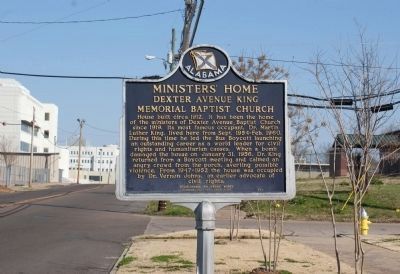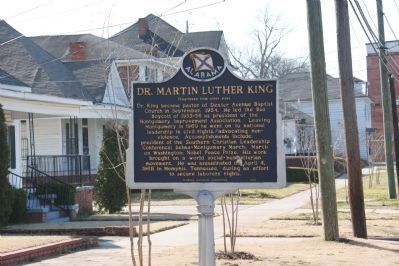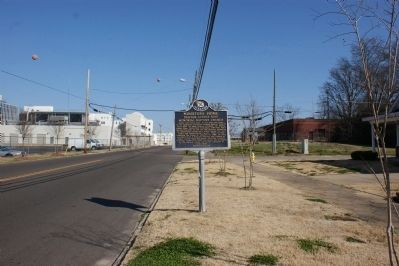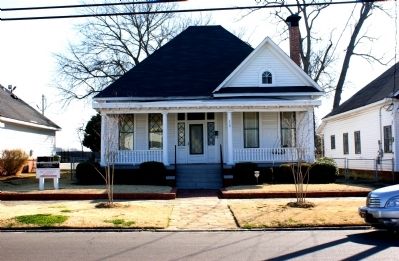Montgomery in Montgomery County, Alabama — The American South (East South Central)
Minister's Home / Dr. Martin Luther King
Dexter Avenue King Memorial Baptist Church
Side A
House built circa 1912. It has been the home of the ministers of Dexter Avenue Baptist Church since 1919. Its most famous occupant, Dr. Martin Luther King, lived here from Sept. 1954-Feb. 1960. During this time he led the Bus Boycott launching an outstanding career as a world leader for civil rights and humanitarian causes. When a bomb damaged the house on January 31, 1956, Dr. King returned from a Boycott meeting and calmed an angry crowd from the porch, averting possible violence. From 1947-1952 the house was occupied by Dr. Vernon Johns, an earlier advocate of civil rights.
Side B
Dr. King became pastor of Dexter Avenue Baptist Church in September, 1954. He led the Bus Boycott of 1955-56 as president of the Montgomery Improvement Association. Leaving Montgomery in 1960 he went on to national leadership in civil rights, advocating non-violence. Accomplishments include: president of the Southern Christian Leadership Conference: Selma-Montgomery March: March on Washington: Nobel Peace Prize. His work brought on a world social-humanitarian movement. He was assassinated on April 4, 1968 in Memphis, Tennessee, during an effort to secure laborers' rights.
Erected 1993 by Alabama Historical Association.
Topics and series. This historical marker is listed in these topic lists: African Americans • Churches & Religion • Civil Rights. In addition, it is included in the Alabama Historical Association, and the Martin Luther King, Jr. series lists. A significant historical month for this entry is January 1900.
Location. 32° 22.385′ N, 86° 17.777′ W. Marker is in Montgomery, Alabama, in Montgomery County. Marker is on South Jackson Street, on the left when traveling south. Touch for map. Marker is at or near this postal address: 350 South Jackson Street, Montgomery AL 36104, United States of America. Touch for directions.
Other nearby markers. At least 8 other markers are within walking distance of this marker. Harris House (within shouting distance of this marker); South Jackson Street / Victor Hugo Tulane (about 300 feet away, measured in a direct line); The Hon. Rufus A. Lewis (about 600 feet away); Aurelia Eliscera Shines Browder (about 700 feet away); Georgia Gilmore (approx. 0.2 miles away); Charles Oscar Harris Family Home (approx. 0.2 miles away); Centennial Hill (approx. 0.2 miles away); Black Bricklayers Hall (approx. ¼ mile away). Touch for a list and map of all markers in Montgomery.
Also see . . .
1. Dexter Parsonage Museum. (Submitted on March 9, 2010, by Bill Pfingsten of Bel Air, Maryland.)
2. UNESCO World Heritage: Civil Rights Movement Site. (Submitted on November 14, 2012, by Richard E. Miller of Oxon Hill, Maryland.)
Additional commentary.
1. Martin Luther King's Contributions To The Civil Rights Movements
Even though Martin Luther King was getting terrorized by whites, he continued to fight for blacks. He started a lot of protests and marches. He is most famous for his big protest march in Washington D.C in 1963. At the Lincoln memorial he performed his famous speech "I have a Dream". It was a big success. On Nov 1963 the government passed a law that gave blacks the same rights as white people. Martin Luther King leadership changed the world
— Submitted October 22, 2012, by Desh''a Anderson of Benton Harbor, Michigan.
Additional keywords. UNESCO World Heritage
Credits. This page was last revised on February 17, 2017. It was originally submitted on March 4, 2010, by Dodson M. Curry of Birmingham, Alabama. This page has been viewed 2,157 times since then and 73 times this year. Last updated on July 25, 2015, by J. Makali Bruton of Accra, Ghana. Photos: 1, 2, 3, 4. submitted on March 4, 2010, by Dodson M. Curry of Birmingham, Alabama. • Bill Pfingsten was the editor who published this page.



